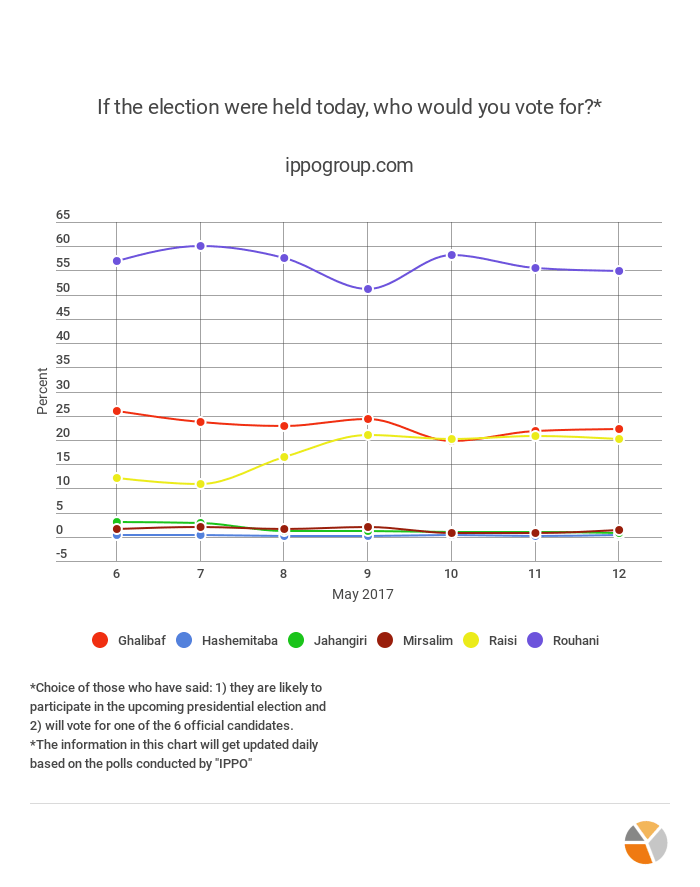Poll Results of May 13

The Vote to Elect the Iranian President
One day after the airing of the third presidential debate, the IPPO poll show that Hassan Rouhani is still the leading candidate with quite a distance from his two main opponents. In the past three days 53% of those who say: 1) they will definitely or likely participate in the May 2017 election and 2) are inclined to vote for one of the six running candidates, have voted for Hassan Rouhani as their first choice. After Rouhani, Mohammad Bagher Ghalibaf’s votes have somewhat increased to 23%. Ebrahim Raisi stands in the third position with 22% of the respondents’ votes. The three other candidates, Mir-Salim, Hashemitaba and Jahangiri are all below 2% in rating (see the above chart).
One should take into account that the margin of error of this poll is between 3-4%. Therefore it is important to focus on tracking, processes and development of patterns involved. Therefore the increase or decrease of a few figures does not indicate a decisive development, unless it is indicative of a meaningful trend.
The current figures are the results of poll tracking from the past three days – that is one day before the third presidential debate, the day of the debate and the day after the debate. To better understand the possible impact of the third debate on the figures, one should closely monitor the poll results from the next few days.
Although the number of undecided voters is steadily falling, seven days to the Election Day still 25% of respondents are undecided and 22% do not express a clear opinion as to whom they may vote for or do express a clear opinion. The undecided voters and those declining to disclose their decisions, and those who do not have a clear opinion can change the outcome and muddle the current patterns (see the chart to the left).
Second Choice Voter Preferences
In the past eight days respondents were asked: “if you were to change your mind before the Election Day, who else will you vote for instead of your first choice?” When comparing the vote-to-vote counts of the undecided voters and those who insist on only voting for one candidate (the decisive voters), once can see that as the number of undecided voters is decreasing, the number of decisive voters is increasing. Also corresponding to this trend, to some extent, the votes of Ebrahim Raisi in the category of second choice candidate is increasing but Ghalibaf’s rating as the second choice candidate has stopped growing.
The Most Unfavorable Candidate
Most respondents still prefer not to indicate which candidate is so unfavorable that they will not vote for him under any circumstances. In other words, almost 46% of the respondents either say that no one among the candidates is the most unpopular or that they cannot or do not wish to name the most unfavorable candidate.
The ranking for the most unfavorable candidate is similar to the ranking of the most favorable candidate. The highest rating of unfavorability is of Hassan Rouhani with 8% and after him Ghalibaf (5%) and Raisi (4%). Jahangiri and Hashemitaba with less that 2% of the unpopularity vote are standing together as the least unfavorable candidates.
Voter Turnout
The rates of participants who are going to vote have remained more or less steady in the past eight days. Around 70% of respondents say they are likely or very likely to vote in the May 2017 presidential election. In contrast, 17% say there is little chance or very little chance that they will participate in the elections. Besides the 6% of respondents that say they are somewhat likely to participate in the elections, 4% of the respondents have not yet reached a decision with regards to participation.
Projections of election participation rates in polls such as this one does not neatly translate to voter turnout rate on the day of the election. Projections of the voter turnout in polls are often more than the actual turnout on the day of the election; this is not unique to the Iranian context and is relevant to all pre-election polling.
Following Presidential Debates
The number respondents who confirm they follow presidential debates are gradually increasing. It should be noted that respondents’ perception of “following debates” is both following the actual debates and the media coverage of the debates as well as candidate’s advertisements broadcasted on the media. As of now about 62% of the respondents say they have been following the election debates and 37% of them say that they have not been following the debates or that they are not aware such debates even exists. The current figures in this category have been gathered in the past three days (the day before to the day after the third debate). As such, any possible increase in the number of participants who have most recently joined the crowd that follows the debate(s) have not been well reflected in the past three polls.
Survey Methodology:
-
This polling was carried out at a national level in Iran from 11 May 2017 to 13 May 2017 and reported on a three-day rolling average basis.
-
The interviews were conducted via phone. Interviewers were trained – both for general skills of phone polling and for the specific needs of this survey. The interviewers were selected post training after passing an interviewing skills exam.
-
The sample size was 1012 Iranians, 18 years and older, who were residing in Iran and were selected randomly.
-
Sampling methodology is a two-stage proportional sampling. It’s on the basis of each of the service operators’ market share and then simple random sampling.
-
Assuming maximum variation, the results of this survey can generalize to the whole of the 18 years and older Iranian (resident in Iran) with a margin of error of ±3.08 to ±4.73 for the 95% confidence interval (based on responses to questions).
-
The data were weighted based on the last available National Iranian Census (2011) with gender, age group and place of residence (urban/rural) as weighting variables.
-
Farsi native speaking interviewers conducted the interviews during daylight hours, local time.
-
The results of each interview was assessed twice by the interviewer and the supervising team – in terms of respondent’s trust in the interviewer and the interviewer’s assessment of the respondents’ honesty.
-
Those respondents who had received very low scores for trust and honesty have been removed from the random sample.


